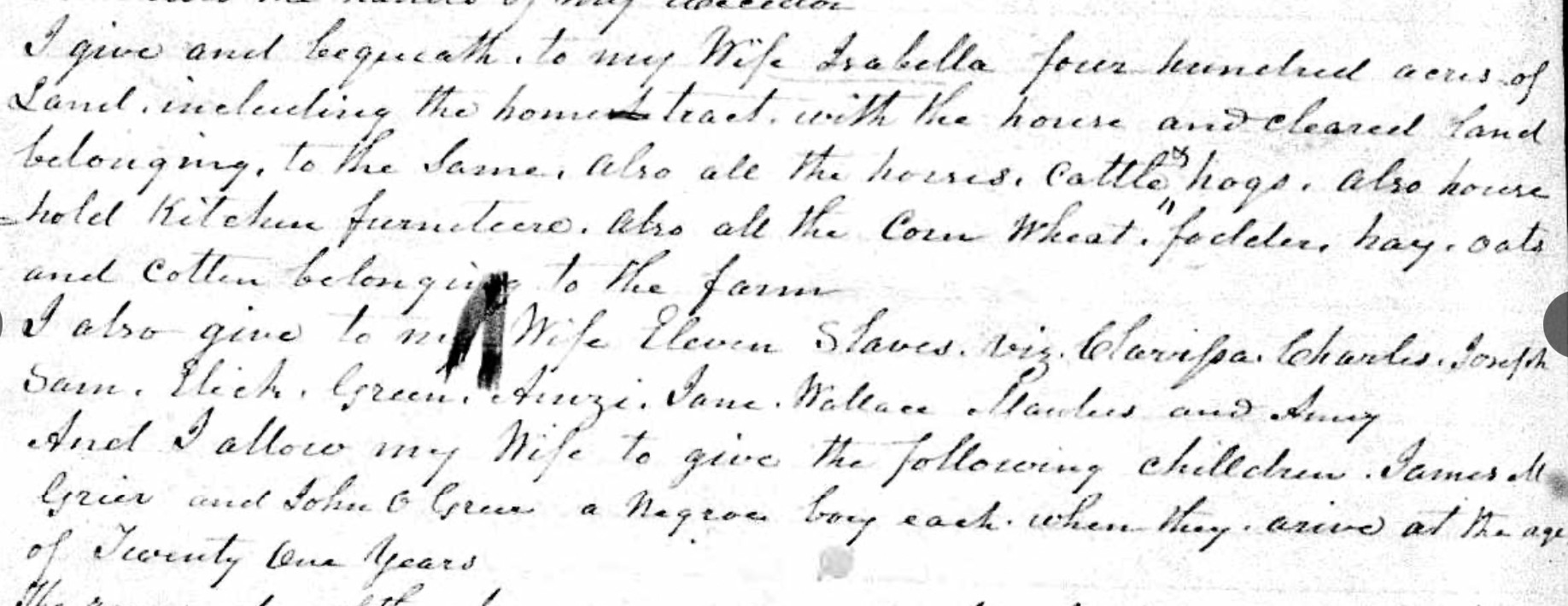What records tell us of the Grier family
The extended Grier family ownership of Reedy Creek land can be traced back through Mecklenburg deeds to before 1826 – the year Ezekiel Robison, listed as an enslaver in the 1810 and 1820 censuses, bequeathed 470 acres to his children, including daughter Isabella. Isabella soon married Isaac Grier, who in 1846 bought out her siblings’ share to own all of those 470 acres, then added more to his holdings. With the labor of enslaved people, he grew cotton (22 bales of 400 pounds each in 1860, a year when only the county’s dozen highest producers topped 40 bales) and other crops, raised milk cows, sheep and pigs, and produced butter.
Isaac’s 1861 will — shown in part below — left to Isabella and four sons more than 600 acres, including the “home tract” in Crab Orchard. He also willed to them 13 named enslaved people: Clarissa, Charles, Joseph, Sam, Elick, Green, Ainzi, Jane, Wallace, Landers, Sousy, Bill and Dan. (These spellings are as close as we can determine from the era’s cursive handwriting.)

The 1860 slave schedules list, by age and gender, 12 Black people enslaved by Isaac Grier: men 50, 25, 24, 20 and two 18-year-old boys; a woman of 47, and girls 18, 15, 15, 14 and 13.
Isaac Grier enslaving people was not rare in Mecklenburg: Nearly 40 percent of Mecklenburg’s 1860 population was enslaved, some 6,800 people.
And while the common misconception is that few white Southerners enslaved people, a look at census data shows that of Mecklenburg’s free “heads of households” – most of the people who could enslave others – about 35 percent did so: about 760 of roughly 2,200.
Again, contrary to what many think, most of the enslavers in Mecklenburg did not hold just one or two people in bondage: 64 percent held more than two – and more than 40 percent enslaved more than five people.
In that 1861 will, Isaac “allowed” Isabella to give their then-15-year-old son John Owen Grier – who would be Mell Grier’s father – “a negro boy” when John turned 21. The Civil War intervened; John enlisted at 17 and fought for the Confederacy, as did two of his brothers. All survived the war. John returned to Crab Orchard, married twice and had 14 children. His first wife – Mell’s and Joe’s mother – Mary Alice (nee Hunter), also inherited land from her family, which came to the Griers when she died.
John ended up with about 300 acres. He died in 1908, and by June 1929, Mell and his older brother Joe had acquired from their dozen siblings all of that land. By 1929, Mell lived there and had bought about 150 more adjoining acres. Joe was living on Queens Road West in Myers Park with his wife and 13-year-old son and ran a livery stable (dealing in horses and feed) uptown on West 6th Street.
— HS
Learn more about racial injustice, and what happened to Joe McNeely and Willie McDaniel here in Charlotte-Mecklenburg, by exploring the rest of this website and EJI’s resources


